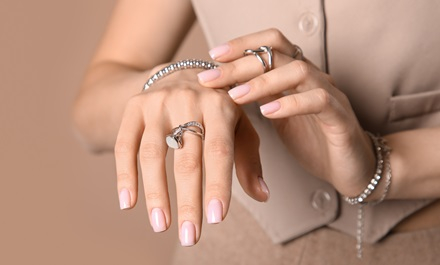Jewellery manufacturers and retailers are pulling out all the stops to navigate challenging business conditions created by the Covid-19 pandemic this year. While full recovery is not yet in sight, the industry is adapting to the new normal with agility and resilience, unveiling a host of innovative strategies and measures to sustain momentum.
The year 2020 is one like no other. The Covid-19 pandemic disrupted business and trading conditions throughout the gem and jewellery pipeline. For months, the international jewellery industry was at a standstill as virus-containment efforts forced the cancellation of physical trade fairs, ushered in digital initiatives to replace in-person trading, and essentially reshaped commercial strategies and operations.
The new normal required jewellery establishments to exercise agility and resilience in order to sustain momentum amid the pandemic. In a series of Return & Recovery webinars organised by JNA magazine and the JNA Awards programme ahead of Informa Markets Jewellery’s virtual event, the Jewellery & Gem Digital World from October 27 to 29, industry leaders and stakeholders shared their key takeaways from this unprecedented crisis and their outlook for recovery.
Diversification
Market diversification, business restructuring and digital initiatives are essential to maintaining growth in a coronavirus-afflicted world, noted speakers at the JNA Conversations: Return & Recovery – The Asian Perspective webinar on September 16.
Ken Lo, chairman of the Hong Kong Jewellery & Jade Manufacturers Association, said that from January to July 2020, the city’s fine jewellery exports fell by nearly 40 per cent due to virus-related slumps in its main markets – the US and Europe. Exports to China and Taiwan however grew by 55.7 per cent and 36.3 per cent respectively.
Noting that the Covid-19 crisis taught the industry not to be too dependent on a single market, Lo cited China and ASEAN (Association of Southeast Asian Nations) as the economies to tap moving forward. China was the first economy to emerge from the Covid-19 pandemic, with businesses reopening in May. It is poised to become a major market for fine jewellery, he added. “ASEAN is a much more diverse and fragmented market so we would need to keep a bigger inventory to cater to the various consumer preferences,” he continued.
Suttipong Damrongsakul, chairman of the ASEAN Gems & Jewellery Association (AGJA), agreed that Southeast Asia offered great potential for growth.
“We learned very expensive lessons from the pandemic. Most of the Thai and ASEAN companies export to Europe, the US and China. When these markets have problems, everything in our part of the world shuts down as well. It is time to consider catering to Asia, which has a population of four billion people,” he said.
Business models
The coronavirus pandemic also forced businesses to rethink their growth and operational strategies. According to Lo, Hong Kong’s jewellery industry, which is mostly export-oriented, realised the need to diversify its manufacturing base and maintain some production capabilities in the city. Over 90 per cent of Hong Kong’s manufacturing facilities are located in China, he noted.
“As borders with the mainland were closed and factories there shuttered, we relocated some functions to Hong Kong, particularly digital and CAD/CAM production that can be handled in the city. We will need to eventually set up a skeleton facility in Hong Kong so when there are difficulties transporting materials across borders, our production will not be crippled,” he explained.
Jewellery businesses could also reconsider their business models to foster growth, according to Damrongsakul. The new normal in a Covid-19 world highlighted the benefits of streamlined operations and production partnerships.
“Companies may no longer need to maintain large workforces. They can focus on their strengths and outsource or partner with others on different components of the business. For instance, those that specialise in jewellery manufacturing but are not proficient in design should join hands with design companies. Italian brands are experts in design; Asian companies are good at manufacturing. They can team up for growth,” the AGJA official explained.
Digital adoption is another area for collaboration, he pointed out. Since most jewellery companies do not have the capability to set up their own platforms, they can work with digital experts to set up an online business. “Covid-19 showed us we do not have to do everything in-house. As we downsize and focus on expenses, we can partner with experts in different fields to maintain growth. You do not have to wait until you’re ready to embark on new aspects of the business,” Damrongsakul said.
Anticipating stronger demand for fashionable, affordable jewellery that requires greater attention to design and pricing, he encouraged businesses to seriously consider shifting from orders and factory work to design and brand development. “More than 80 per cent of companies in ASEAN are OEMs. When buyers stop orders and payments, they are in big trouble. The key to long-term survival is creating and selling their own designs and having a branding strategy,” he explained.
Retail measures
Jewellery retailers likewise found themselves making significant adjustments to cater to their customers during the Covid-19 crisis. Virus-induced lockdowns and social-distancing measures accelerated the adoption of digital initiatives, cross-industry collaborations and omnichannel strategies, according to speakers at two Return & Recovery webinars – Retail Strategies in a Covid-19 World on October 5 and The Asian Retail Market on October 12.
Indonesia’s PT Central Mega Kencana kept customers engaged during the pandemic through client outreach and social media campaigns on healthcare, shop-from-home initiatives, and entertainment content such as virtual concerts and Instagram filters. Group Creative Director Tanya Alissia said, “We are now in the ‘low touch’ economy so maximum effort to go digital is really necessary.”
The multi-brand retailer initiated closer collaborations with other industries to entertain customers and expand its network through database sharing. “When you choose the right partner to collaborate with, these partnerships can be highly effective. Database sharing with banks was common pre-pandemic. We extended this to fashion designers and musicians too,” Alissia commented.
Cross-industry partnerships likewise appeal to India’s Kashi Jewellers. Vice President and Partner Shreyansh Kapoor is setting aside an area for pop-up exhibits of luxury watches and high-end clothing lines in the retailer’s upcoming showroom.
Omnichannel focus
Covid-19 hastened the adoption of digital initiatives, thereby reinforcing the online-to-offline (O2O) strategy.
Chow Tai Fook Jewellery Group Ltd introduced a number of new O2O initiatives to enhance customer experience at physical stores while engaging with clients online, said Executive Director Bobby Liu. These include Cloud Kiosks that link online orders at physical stores to the group’s e-commerce platform, and Z+ Funhouse, an innovative jewellery retail space that fosters social interaction, AI and product customisation.
The group is also cultivating the spirit of entrepreneurship in its staff, Liu said. Its Cloudsales 365 app encourages employees to sell jewellery products to their contacts. “The retail and O2O technology we developed and introduced have proven very effective in connecting with our clients, especially during the Covid-19-induced lockdowns. We developed our private domain to engage with customers and lead them to our online or physical stores,” he added.
Covid-19 has changed the way people access information and altered their shopping behaviour, with more consumer segments growing comfortable with digital channels, remarked Angelina Lau, general manager for International Operations of Singapore’s SK Jewellery Group.
“We call it omni-commerce rather than omnichannel since the goal is to eventually generate sales. But business owners must lead and spearhead changes for the strategy to work,” Lau commented.
SK has introduced new digital tools and solutions including livestreaming sessions, Click & Collect services at selected stores, online payment options, and one-on-one virtual consultations.
Livestreaming and TikTok are among the channels Vietnam’s Phu Nhuan Jewelry Joint Stock Company (PNJ) has explored in recent months, while Dhamani Jewels in the UAE engages customers by sending jewellery to be viewed at their homes and creating dedicated e-catalogues for specific clients.
“Jewellery retailers are all trying and testing various models to navigate the new normal,” said the group’s Managing Director Amit Dhamani. “There is no single solution that will lead to success. We have to mix and match strategies for best possible outcomes.”
Product development
The Covid-19 era is also instituting significant changes in consumer preferences. Lower-priced items tend to move better online across all markets than bigger-ticket items, the retailers noted.
Pranda Group Chairman Prida Tiasuwan said consumers are willing to spend up to US$1,000 on jewellery online; anything costlier would normally be bought at physical stores. To be successful online though, companies need to establish strong and effective brands, he added.
Lower-priced items are better suited for market conditions ahead as economic uncertainties dampen consumer spend. Gold products are also in demand due to their investment value, the Pranda official continued.
In Singapore, affordable pieces and gifting purchases are popular online. Essential items such as bridal jewellery pieces still sell but with couples sometimes making slight adjustments to their budgets, Lau shared.
For the UAE’s Dhamani Jewels, its brand of trendy pieces, Dusoul by Dhamani, thrived in recent months as consumers – particularly millennials – sought affordable luxury jewellery. “Impromptu buying continues to do well. We have seen a slowdown in demand for jewellery purchases for life events such as weddings. This affected the classic fine jewellery and statement pieces from our main Dhamani 1969 brand. Jewellery for occasions such as anniversaries are still sought after," Dhamani revealed.
PT Central Mega Kencana's Alissia noted growing interest in meaningful jewellery as consumers seek pieces with significance and relevance to their lives. Millennials, in particular, want stories behind their jewellery as they ponder life in a pandemic.
Chow Tai Fook is building on this trend too through jewellery personalisation tools. Its D-One jewellery customisation online platform enables customers to design their own piece while its new Art2Charm service transforms customers’ drawings or pictures into 18-karat gold charms.
Opportunities amid adversity
There are also still bright spots in the jewellery retail scene despite the pandemic as retailers adapted and adopted new business models and growth strategies.
Vietnam’s PNJ managed to post growth during coronavirus-afflicted months by seizing opportunities in the market, revealed CEO Le Tri Thong.
Through database management, PNJ sharpened its market segmentation strategy. It also optimised its retail network by moving into prime locations vacated by travel agencies and tourism services. Priority has shifted too from large numbers of shopping points to more effective points of sale.
“We analysed the different market segments to identify who has disposable income and what their purchasing habits are. The approach has shifted from mass market to more detailed customisation of products and communications for specific segments. We target professionals in thriving sectors such as banking over hard-hit fields such as tourism. In rural areas, we offer products with a high concentration of gold that can be converted to cash,” Le revealed.
Over in Hong Kong, the jewellery retail sector, which relies heavily on tourist purchases, is turning to local consumption to compensate for the loss of Chinese and international visitors, Lee Heng Diamond Group CEO Lawrence Ma pointed out. Meanwhile, travel restrictions enabled SK Jewellery Group to woo local consumers who previously made their luxury purchases overseas, Lau revealed. Jewellery retail likewise benefits from discretionary income diverted from the luxury travel market and high fashion sector, the retailers noted.
Changing face of retail
Moving forward, the role and number of physical stores are likely to change as consumers adapt to the new normal, according to Pranda's Tiasuwan.
Nine months of coronavirus-related lockdowns, social-distancing measures and containment efforts have turned people into dedicated netizens. “Even with the high-touch nature of jewellery, purchase decisions in the future will be omnichannel. Consumers will go online to research on their options, and then go to the store to buy it once they have decided,” he continued.
The growing importance of investment jewellery will warrant enhanced and efficient customer service, Tiasuwan said. Retailers will need to do more to get customers into the store, and sales personnel must be knowledgeable about big-ticket items, he added.
Ma of Lee Heng Diamond Group affirmed the interdependence of online and offline channels, and underscored the importance of customer experience. Online platforms enable retailers to engage with their customers, but brick-and-mortar outlets validate the brand experience through engaged and empowered frontliners.
For Kashi Jewellers, the tactile and emotional nature of jewellery buying will keep brick-and-mortar stores relevant in an age of digitalisation. During the lockdown, it allowed customers to try jewellery on and installed a high-pressure steamer in its showroom to sanitise pieces handled by customers. The retailer’s new showroom will include a factory floor where customers can watch artisans create jewellery.
“Jewellery buying is a high-touch and social activity. Customers want their friends’ opinion on their purchases. They want to feel the jewellery piece. Online and retail technology are all well and good but, for us, they don’t necessarily translate into sales,” said Kapoor.
Return & Recovery webinars
The Asian Perspective
September 16, 2020
• Hong Kong Jewellery & Jade Manufacturers Association Chairman Ken Lo
• ASEAN Gems & Jewellery Association Chairman Suttipong Damrongsakul
Retail Strategies in a Covid-19 World
October 5, 2020
• PT Central Mega Kencana Group Creative Director Tanya Alissia
• SK Jewellery Group General Manager International Markets Angelina Lau
• Lee Heng Diamond Group CEO Lawrence Ma
• Pranda Group Chairman Prida Tiasuwan
The Asian Retail Market
October 12, 2020
• Dhamani Jewels Managing Director Amit Dhamani
• Kashi Jewellers Vice President and Partner Shreyansh Kapoor
• Phu Nhuan Jewelry Joint Stock Company CEO Le Tri Thong
• Chow Tai Fook Jewellery Group Ltd Executive Director Bobby Liu
View webinars here.
















